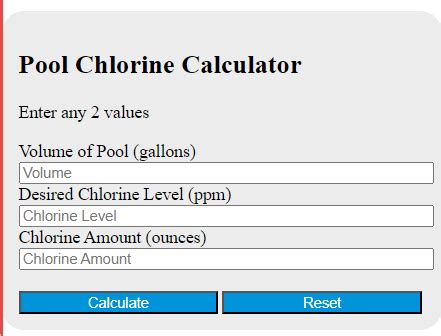Simple Chlorine Calculation: Your Pool Calculator Guide
Maintaining a sparkling clean and safe swimming pool requires careful attention to water chemistry. One of the most crucial aspects is ensuring the correct chlorine levels. Too little chlorine can lead to algae growth and bacteria, while too much can irritate skin and eyes. This guide provides a simple approach to chlorine calculation, empowering you to maintain your pool's hygiene effectively. We'll cover various aspects, addressing common questions and concerns.
What is Chlorine and Why is it Important?
Chlorine is a powerful disinfectant used to kill bacteria, viruses, and algae in swimming pools. It’s essential for maintaining a healthy and safe swimming environment. Proper chlorine levels are crucial for preventing the spread of waterborne illnesses and keeping your pool clear and inviting. Understanding how to calculate and maintain the correct chlorine concentration is paramount for responsible pool ownership.
How to Calculate Chlorine Needs: A Step-by-Step Guide
Calculating the correct amount of chlorine needed involves several factors. While dedicated pool calculators offer precise measurements, understanding the basic principles empowers you to make informed decisions. Here's a simplified approach:
1. Determine Your Pool's Volume:
This is the most critical step. Accurate measurement is essential for accurate chlorine dosing. For simple rectangular pools, the calculation is straightforward: length x width x average depth. For more complex shapes, you might need to break the pool into smaller sections and add their volumes. Online pool volume calculators can assist with irregular shapes.
2. Check Your Current Chlorine Levels:
Use a reliable test kit (liquid test kits are generally more accurate than test strips) to measure your current free chlorine levels (FC). These kits typically provide clear instructions on how to conduct the test and interpret the results, usually measured in parts per million (ppm).
3. Determine the Desired Chlorine Level:
The ideal free chlorine level for most pools ranges from 1 to 3 ppm. Higher levels might be necessary during periods of heavy use or extreme weather. Your local pool supply store can provide tailored recommendations based on your specific climate and pool type.
4. Calculate the Chlorine Needed:
This step involves subtracting your current chlorine level from your desired level. The result represents the amount of chlorine you need to add per gallon of water. Then, multiply this amount by your pool's total volume (in gallons) to determine the total amount of chlorine needed.
Example:
- Pool volume: 10,000 gallons
- Current FC level: 0.5 ppm
- Desired FC level: 2 ppm
- Chlorine needed per gallon: 2 ppm - 0.5 ppm = 1.5 ppm
- Total chlorine needed: 1.5 ppm x 10,000 gallons = 15,000 ppm = 15,000 mg (since 1 ppm = 1 mg/L and assuming 1 gallon ≈ 3.785 L) This needs to be converted to the appropriate amount based on your chlorine product's concentration. For example if using a 6% chlorine solution 15000 mg / (60000 mg/100g)= 25g (approximately)
5. Add Chlorine Gradually and Retest:
Never add chlorine directly to the pool. Dilute it in a bucket of pool water before slowly pouring it into the pool, away from any swimmers. Always retest your water after adding chlorine to ensure you've achieved the desired level.
What if my chlorine levels are too high?
High chlorine levels can irritate skin and eyes. To lower chlorine levels, you can simply wait as the chlorine dissipates naturally through sunlight and use. Partially draining and refilling the pool is another option, although more involved. Consult your local pool professional for the best course of action.
What type of chlorine should I use?
Several types of chlorine are available, including granulated chlorine, chlorine tablets, and liquid chlorine. Each has its pros and cons regarding application and cost-effectiveness. Consult your local pool supply store for guidance on selecting the most appropriate type for your pool.
How often should I check and adjust my chlorine levels?
Ideally, you should test your pool water at least twice a week, and more frequently during periods of heavy use or hot weather. Regular testing is crucial for maintaining a safe and healthy swimming environment.
What are the other important pool chemicals I need to consider?
Maintaining proper pH levels, alkalinity, and calcium hardness is just as critical as chlorine levels. These factors interact and influence each other, impacting the overall effectiveness of your chlorine and the overall health of your pool.
This guide provides a simplified approach to chlorine calculations. Remember to always follow the instructions provided with your specific chlorine product and consult with a pool professional if you have any doubts or concerns. Maintaining proper chlorine levels is vital for ensuring your pool is a safe and enjoyable space for everyone.

